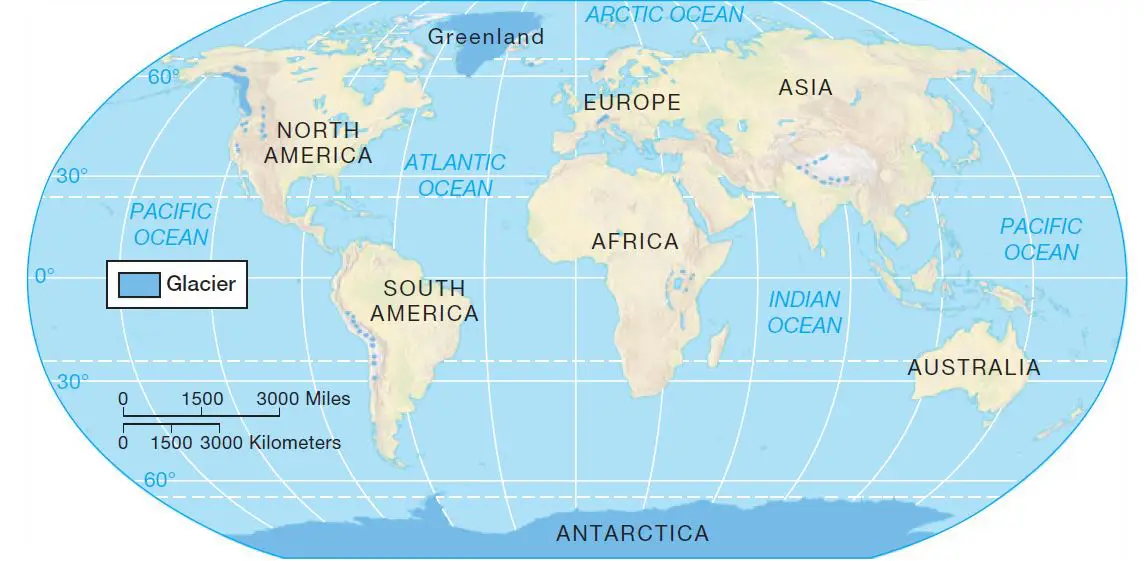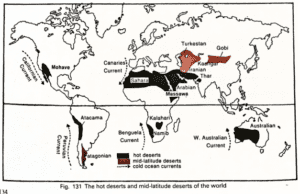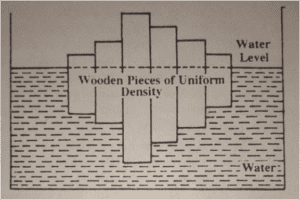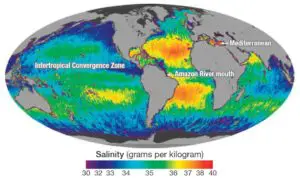Table of Contents
Cryosphere and Permafrost | Geography Optional | UPSC – IAS
The cryosphere is those portions of Earth’s surface where water is in solid form, including sea ice, lake ice, river ice, snow cover, glaciers, ice caps, ice sheets, and frozen ground. Thus, there is a wide overlap with the hydrosphere.
- Second only to the world ocean as a storage reservoir for moisture is the solid portion of the hydrosphere – the ice of the world, or cryosphere, Although minuscule in comparison with the amount of water in the oceans, the moisture content of ice at any given time is more than twice as large as the combined total of all other types of storage (groundwater, surface waters, soil moisture, atmospheric moisture, and biological water).
- The ice portion of the hydrosphere is divided between ice on land and ice floating in the ocean, with the land portion being the larger. Ice on land is found as mountain glaciers, ice sheets, and ice caps,
- Approximately 10 percent of the land surface of Earth is covered by ice. It is estimated that enough water is locked up in this ice to feed all the rivers of the world at their present rate of flow for nearly 900 years.
Oceanic ice has various names, depending on size:
- Ice pack: An extensive and cohesive mass of floating ice.
- Ice shelf: A massive portion of a continental ice sheet that projects out over the sea.
- Ice floe: A large, flattish mass of ice that breaks off from larger ice bodies and floats independently.
- Iceberg: A chunk of floating ice that breaks off from an ice shelf or glacier.
Because ice has a lower density than that of liquid water, only about 14 percent of the mass of an iceberg is exposed above the water, with about 86 percent below. Despite the fact that some oceanic ice freezes directly from seawater, all forms of oceanic ice are composed almost entirely of freshwater because the salts present in the seawater in its liquid state are not incorporated into ice crystals when that water freezes. The largest ice pack covers most of the surface of the Arctic Ocean;
- On the other side of the globe, an ice pack fringes most of the Antarctic continent. Both of these packs become greatly enlarged during their respective winters, their areas are essentially doubled by increased freezing around their margins.
- Sea ice in the Arctic especially has been diminishing over the last 35 years (Because of Climate Change)
- There are a few small ice shelves in the Arctic, mostly around Greenland, but several gigantic shelves are attached to the Antarctic ice sheet, most notably the Ross Ice Shelf of some 100,000 square kilometers (40,000 square miles). Some Antarctic ice floes are enormous; the largest ever observed was 10 times as large as the state of Rhode Island.
How does the cryosphere affect/impact global climate? | UPSC – IAS
Over the last two decades, because of increasing temperatures, formerly stable ice shelves in Antarctica have broken apart. Since the early 1990s as much as 8000 square kilometers (over 3000 square miles) of Antarctic ice shelves have disintegrated.
- In 2002, the Larsen-B Ice Shelf on the Antarctic Peninsula disintegrated in less than a month, and the much larger Larsen-C shelf just to the south is showing signs that its mass is being reduced because of increasing water temperatures below it. In 2008, the Wilkins Ice Shelf in Antarctica also began to disintegrate.
- Dut due to global warming, some of the ice-sheets are getting melt, Thus, presence or absence of snow and ice affects the heating and cooling of Earth’s surface. This influences the entire planet’s energy balance.
- It plays important role in cooling the air which affects the climate of the regions of Iceland, Greenland, Russia etc
- The polar region acts as carbon sink and trapped tonnes of carbon inside its soil. If the frozen water form like sea ice, lake ice, river ice, snow cover, glaciers, ice caps, ice sheets, and frozen ground melts then it will release in form of methane (greenhouse gas) – which will act as a catalyst for the global warming.
Permafrost and Thawing of Permafrost | UPSC – IAS
Permafrost is any ground that remains completely frozen – 32°F (0°C) or colder, for at least two years straight. A relatively small proportion of the world’s ice occurs beneath the land surface as ground ice.
- This type of ice occurs only in areas where the temperature is continuously below the freezing point, and so it is restricted to high-latitude and high-elevation regions. Most permanent ground ice is permafrost, which is permanently frozen subsoil.
- It is widespread in northern Canada, Alaska, and Siberia and found in small patches in many high mountain areas. Some ground ice is aggregated as veins of frozen water, but most of it develops as ice crystals in the spaces between soil particles.
Thawing of Permafrost: Why is permafrost melting a problem? | UPSC – IAS
In locations such as the region around the city of Fairbanks in central Alaska, permafrost is widespread just below the surface. During the summer, only the upper 30 to 100 centimeters (12 to 40 inches) of soil thaws in what is called the active layer;
- Below that is a layer of permanently frozen ground perhaps 50 meters (165 feet) thick. Much of the permafrost found in the high latitude areas of the world has been frozen for at least the last few thousands of years, but as a response to higher average temperatures, it is beginning to thaw.
In just the last 35 years, a warming trend has been observed, bringing the ground temperature in some areas above the melting point of the permafrost. Deep in the permafrost layer where ground still remains frozen, temperatures are rising also. For people accustomed to living in temperate environments, it might seem that having the ground thaw would not be a problem, but such is not the case.
- As the ground thaws, buildings, roads, pipelines, and airport runways are increasingly destabilized, and transportation and business are likely to be disrupted as a consequence.
- In areas with poor surface drainage, the degradation of permafrost can lead to what is called wet thermokarst conditions, where the surface subsides and the ground becomes oversaturated with water. In some cases, unpaved roads become impassible.
In the last three decades, the number of days that the Alaska Department of Natural Resources permits oil exploration activity in areas of tundra has been cut in half due to the increasingly soft ground. Along the Beaufort Sea, rising temperatures are thawing permafrost in the coastal bluffs and contributing to more rapid erosion of the coastline.
- From an average rate of erosion of 6 meters (20 feet) per year between the mid- 1950s and 1970s, the rate jumped to nearly 14 meters (45 feet) per year between 2002 and 2007.
- The thawing of frozen soils will likely lead to an increase in the activity of microorganisms in the soil. This could in turn increase the rate of decomposition of organic matter long sequestered in the frozen ground.
- As this organic matter is decomposed by microorganisms, carbon dioxide or methane can be released, perhaps contributing to increasing greenhouse gas concentrations in the atmosphere.





